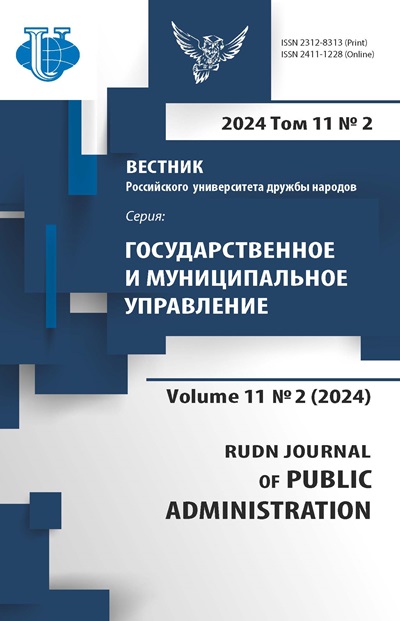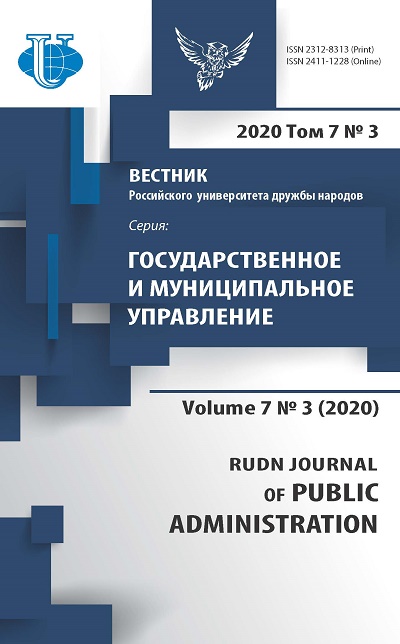Африканская архитектура мира и безопасности как инструмент их поддержания. Часть 1
- Авторы: Гардашью Б.Д.1
-
Учреждения:
- Университет Бахир Дар
- Выпуск: Том 7, № 3 (2020)
- Страницы: 179-194
- Раздел: АКТУАЛЬНЫЕ ПРОБЛЕМЫ ГОСУДАРСТВЕННОГО УПРАВЛЕНИЯ
- URL: https://journals.rudn.ru/public-administration/article/view/24516
- DOI: https://doi.org/10.22363/2312-8313-2020-7-3-179-194
Цитировать
Полный текст
Аннотация
В статье критически анализируется эффективность Африканской архитектуры мира и безопасности (ААМБ) (в которую входят Африканские резервные силы (АРС), Континентальная система раннего предупреждения (КСРП), Группа мудрецов и Фонд мира (ФМ)) в достижении своих институциональных целей. Также автором оценивается потенциальный вклад структур ААМБ в работу Совета мира и безопасности Африканского союза (АС СМБ). Совет мира и безопасности как ключевая опора Африканской архитектуры мира и безопасности является основным директивным органом по данным вопросам. Для выполнения своих обязанностей Совет мира и безопасности Африканского союза будет поддерживаться Африканскими резервными силами, Континентальной системой раннего предупреждения, Группой мудрецов и Фондом мира. ААМБ - это общий термин для обозначения ключевых механизмов Африканского союза для содействия миру, безопасности и стабильности на африканском континенте. В частности, это оперативная структура для эффективного осуществления решений, принятых в областях предотвращения конфликтов, миротворчества, операций по поддержанию мира и вмешательства, а также миростроительства и постконфликтного восстановления. ААМБ рассматривается как средство, с помощью которого Африка может играть более активную роль в управлении миром и безопасностью на континенте с целью предложить «африканские решения африканских проблем».
Об авторах
Бевукету Дирес Гардашью
Университет Бахир Дар
Email: bewuket23@gmail.com
преподаватель и исследователь департамента политологии и международных исследований 79, Бахр-Дар, Амхара, Эфиопия
Список литературы
- Protocol Relating to the Establishment of the Peace and Security Council of the African Union. Adopted by the 1st Ordinary Session of the Assembly of the African Union. Durban: African Union; 2002.
- Kasumba Y., Debrah C. An Overview of the African Standby Force (ASF). The Civilian Dimension of the African Standby Force. De Coning C., Kasumba Y. (Eds.). Addis Ababa: African Union Commission; 2010: 10-19.
- The Policy Framework for the Establishment of the African Standby Force and the Military Staff Committee. Adopted by the Third Meeting of African Chiefs of Defense Staff; 2003.
- Beza Y.T. The “African Solutions for African Problems”: Challenges for the African Standby Force (ASF). Journal of Social Sciences and Humanities. 2015; 4 (1): 450-457.
- Decision on the outcome of the retreat of the Assembly of the African Union Assembly/AU/Dec.605 (XXVII). Twenty-seventh Ordinary Session. Kigali: Rwanda; 2016.
- Albuquerque A.L. The African Peace and Security Architecture (APSA): Discussing the Remaining Challenges (FOI-R-4301-SE). Sweden: Ministry of Defense; 2016.
- Okeke J.M. United in Challenges? The African Standby Force and the African Capacity for the Immediate Response to Crises. The Future of African Peace Operations: From Janjaweed to Boko Haram. De Coning C., Gelot L., Karlsrud J. (Eds.). London: Zed Books; 2016: 90-105.
- De Coning C. Adapting the African Standby Force to a Just-in-time Readiness Model: Improved Alignment with the African Model of Peace Operations. The Future of African Peace Operations: From Janjaweed to Boko Haram. De Coning C., Gelot L., Karlsrud J. (Eds.). London: Zed Books; 2016: 120-134.
- Darkwa L. The African Standby Force: The African Union’s Tool for the Maintenance of Peace and Security. Contemporary Security Policy. 2017; 38: 471-482. doi: 10.1080/13523260.2017.1342478
- Ani C.N. Is the African Standby Force any Closer to Being Deployed? Institute for Security Studies. 2018. URL: https://issafrica.org/iss-today/is-the-african-standby-force-any-closer-to-being-deployed. Accessed: 26.03.2020.
- Wambua M.R. Securing Africa: The Role of the African Standby Force. University of Nairobi, Kenya: Unpublished Master’s Thesis; 2015.
- Koops J., Varwick J. Ten Years of SHIRBRIG: Lessons Learned, Development Prospects and Strategic Opportunities for Germany. Berlin: Global Public Policy Institute; 2008.
- African peace and security architecture. APSA Roadmap 2016-2020. AU Commission. Addis Ababa: Ethiopia; 2015.
- Gänzle S., Franke B. African Developments: Continental Conflict Management: A Glass Half Full or Half Empty? No. 7, briefing paper. Bonn: German Development Institute; 2010.
- Williams P.D. The African Union’s Conflict Management Capabilities. New York: Council on Foreign Relations; 2011.
- Berhe M.G., Waal A. Peace Missions in Africa: Constraints, Challenges, and Opportunities: Preliminary Report to the African Union. Addis Ababa: Ethiopia; 2015.
- Odote P.O. Role of Early Warning Systems in Conflict Prevention in Africa: Case Study of the Ilemi Triangle. Doctoral Dissertation. Nairobi: University of Nairobi; 2016.
- Aning K. The African Union’s Peace and Security Architecture: Defining an Emerging Response Mechanism. Lecture series (no 3) on African security. Ghana: Accra; 2008.
- Wondemagegnehu D.Y. An Exploratory Study of Harmonization of Conflict Early Warning in Africa. Master Thesis. Leipzig: Universities of Leipzig; 2009.
- Brett J. The Inter-relationship between the African Peace and Security Architecture, the Global Peace and Security Architecture and Regional Initiatives. Report prepared for the Danish Embassy in Addis Ababa 24th October 2013. URL: http://um.dk/en/~/media/UM/English-site/Documents/Danida/About-Danida/ Danida%20transparency/Documents/Grant%20committee/2013/Ext%20doc/02a% 20Annex%20A%20%20APSA%20Study.pdf. Accessed: 27.03.2020.
- Aniche E.T., Egbuchulam M.U. Is African Peace and Security Architecture the Solution? Analyzing the implications of escalating conflicts and security challenges for African integration and development. A paper delivered at the 30th annual conference of the Nigerian political science association Southeast chapter on the theme: Elections, security challenges and African development. Port Harcourt: University of Port Harcourt; 2016
- Arthur P. Promoting Security in Africa through Regional Economic Communities (RECs) and the African Union’s African Peace and Security Architecture (APSA). Insight on Africa. 2017; 9 (1): 1-21. doi: 10.1177/0975087816674577
- Engel U. Knowledge Production on Conflict Early Warning at the African Union. South African Journal of International Affairs. 2018; 25 (1): 117-132. DOI: 10.1080/ 10220461.2018.1417902
- Affa’a-Mindzie M. Preventing Conflicts in Africa: Early Warning and Response. In meeting note. New York, NY: International Peace Institute; 2012.
- An Early Warning on Africa's Early Warning System. 2015. Institute for Security Studies. URL: https://issafrica.org/pscreport/psc-insights/an-early-warning-on-africas-early-warning-system. Accessed: 27.03.2020.
- Noyes A., Yarwood J. The AU Continental Early Warning System: From Conceptual to Operational? International Peacekeeping. 2013; 20 (3): 249-262. DOI: 10.1080/ 13533312.2013.838393
- Wulf H., Debiel T. Systemic Disconnects: Why Regional Organizations Fail to Use Early Warning and Response Mechanisms. Global Governance. 2010; 16 (4): 525-547.
- Fisher L.M., Bah A.S., Mniema A., Okome H.N., Tamba M., Frederiksen J., Reeve R. Moving Africa Forward: African Peace and Security Architecture (APSA). Assessment Study. Addis Ababa: AU Peace and Security Department; 2010.
- Jegede A.O. The African Union Peace and Security Architecture: Can the Panel of the Wise Make a Difference? African Human Rights Law Journal. 2009; 9 (2): 409-433.
- Porto J.G., Ngandu K.Y. The African Union, Preventive Diplomacy, Mediation, and the Panel of the Wise: Review and Reflection on the Panel’s First Six Years. African Security. 2014; 7 (3): 181-206. doi: 10.1080/19392206.2014.952582
















